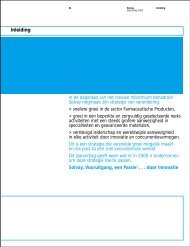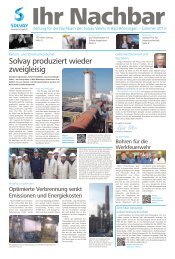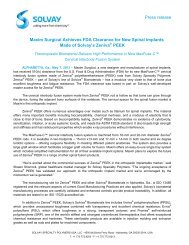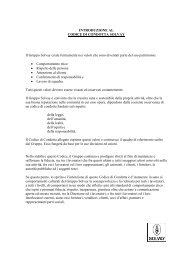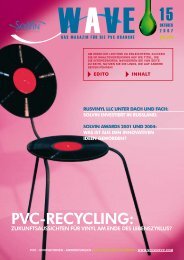Design Guide - Solvay Plastics
Design Guide - Solvay Plastics
Design Guide - Solvay Plastics
Create successful ePaper yourself
Turn your PDF publications into a flip-book with our unique Google optimized e-Paper software.
Figure 59: HDT of 30% - 33% GR Resins<br />
Deflection Temperature, °C<br />
300<br />
280<br />
260<br />
240<br />
220<br />
200<br />
180<br />
160<br />
A-1133 HS PA 6,6 PPS PEI<br />
In summary, deflection temperature does not measure<br />
thermal capability, it simply provides one point on the<br />
modulus versus temperature curve.<br />
In general, HDT can only be used as a general indicator<br />
of short-term thermal capability. It is useful for comparing<br />
similar materials but can be misleading if, for example,<br />
an amorphous material is compared to a semi-crystalline<br />
material. It doesn’t provide any information about longterm<br />
thermal stability. The actual loads and performance<br />
requirements will dictate the suitability of the material.<br />
Many semi-crystalline resins can be used in applications<br />
that experience temperatures higher than their deflection<br />
temperature value.<br />
Deflection Temperature Values for<br />
Amodel Resins<br />
Deflection temperature values by both ASTM D648<br />
and ISO 75Af for 19 representative grades of Amodel ®<br />
PPA are shown in the Tables starting on page 7.<br />
Figure 59 compares the deflection temperature at<br />
1.8 MPa (264 psi) of Amodel AS-1133 HS resin with<br />
a 33% glass fiber reinforced PA 6,6, a 30% glass fiber<br />
reinforced polyphenylene sulfide, and a 30% glass<br />
fiber reinforced polyetherimide. Amodel resin offers<br />
a 75°C HDT advantage relative to PEI, a 42°C advantage<br />
relative to PA 6,6, and a 22°C advantage relative to PPS.<br />
550<br />
500<br />
450<br />
400<br />
350<br />
Deflection Temperature, °F<br />
Coefficient of Linear Thermal Expansion<br />
The dimensions of most materials increase with<br />
increasing temperature. The coefficient of linear thermal<br />
expansion (α) is the ratio of the change in length to the<br />
change in temperature.<br />
If the coefficient α is known, the change in length of an<br />
uniform straight bar raised to a temperature T f can be<br />
calculated from:<br />
where<br />
ΔL = αL (T F<br />
− T O<br />
)<br />
ΔL = change in length<br />
L = original length<br />
α = coefficient of linear thermal expansion<br />
T F<br />
= final temperature<br />
T O<br />
= original temperature<br />
The coefficient of linear thermal expansion (α), as<br />
measured by ASTM E831, of several Amodel grades<br />
and some common metals is given in Table 19. This<br />
method provides an average value for the expansion<br />
coefficient over a temperature range.<br />
The thermal expansion behavior of metals is uniform<br />
over the temperature range of concern. As shown in<br />
Table 19, the thermal expansion coefficients of the<br />
polymer materials are a function of the temperature<br />
range used for the measurement. In general, the<br />
polymer materials expand slightly more above their<br />
glass transition temperature than they do below it and<br />
the behavior in the vicinity of the T g is also somewhat<br />
non-linear. However, over large temperature ranges,<br />
the variations are usually insignificant and excellent<br />
prediction of dimensional properties can be obtained<br />
using the values provided in the table. Also, the addition<br />
of glass fiber and other reinforcing additives results in<br />
the thermal expansion becoming directional. Since fibers<br />
tend to become oriented in the flow direction, and since<br />
glass has a lower thermal expansion coefficient than<br />
the polymers, the coefficient of expansion are generally<br />
lower in the flow direction than the transverse direction.<br />
The values shown in Table 19 should allow the design<br />
engineer to estimate the magnitude of the thermal<br />
stresses in parts molded from Amodel resins due<br />
to thermal expansion.<br />
Property Data<br />
Amodel ® PPA <strong>Design</strong> <strong>Guide</strong><br />
43



